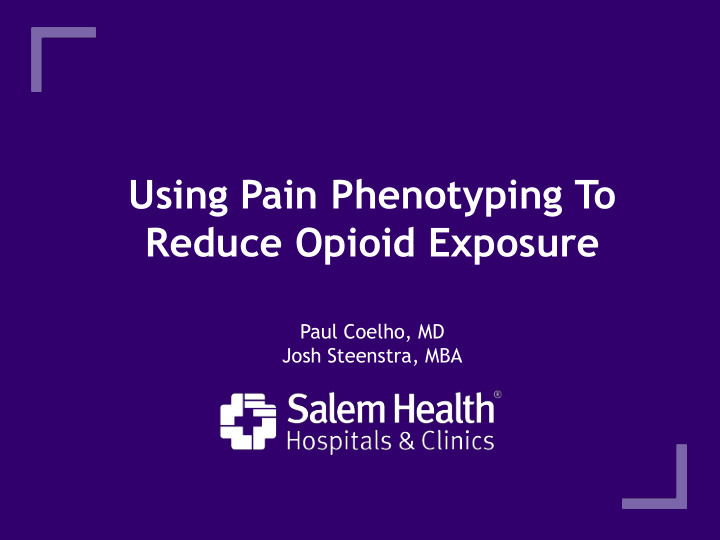



Using Pain Phenotyping To Reduce Opioid Exposure Paul Coelho, MD Josh Steenstra, MBA
Disclosures Dr. Coelho & Mr. Steenstra have no relevant disclosures. We will not be discussing any off-label uses of medications or devices.
Table of contents: Epidemiology of the opioid epidemic • Oregon opioid prescribing • • Pain phenotyping Salem Clinic 18mo data • • Sample Case Evidence-Based Treatments • • ICD10 Codes
Epidemiology of the Opioid Epidemic
US Overdose Deaths 1980-2017 Peak Incidence Ages 45-54 Peak Incidence of Prescription ODD Age 45-54* 67K 50000 37500 25000 12500 6K 0 1980 2017
OD’s Vs Guns Vs MVA’s
US OD Hospitalizations By Race https://www.cdc.gov/nchs/products/databriefs/db294.htm
International Opioid Prescribing 2012-2014 https://www.ncbi.nlm.nih.gov/pubmed/28792397
International Oxycodone Prescribing
International Prevalence of Chronic Pain https://www.ncbi.nlm.nih.gov/pubmed/28792397
Oregon & Prescribed Opioids
2011 Oregon Opioid Prescribing for SSD Recipients < 65yrs https://www.ncbi.nlm.nih.gov/pmc/articles/PMC4151179/
Opioid Prescribing for Fibromyalgia 2007-09 https://www.ncbi.nlm.nih.gov/pmc/articles/PMC4346177/
Pain Phenotyping to Reduce Opioid Exposure
2018 Model of MSK Pain Nociceptive Neuropathic Nociplastic Primarily due to Damage or entrapment of Primarily due to a inflammation or tissue peripheral nerves. central disturbance in damage in the periphery pain processing. NSAID/Opioid Responsive Responds to both Tricyclic neuro-active peripheral and central compounds. Opioid pharmacotherapy. unresponsive. Responds to procedures. Does not respond to Does not respond to procedures. procedures. Behavioral factors minor. Behavioral factors minor. Behavioral Factors Prominent. Examples: Osteoarthritis, Examples: Diabetic Examples: FMS, cLBP, Rheumatoid arthritis, peripheral neuropathy, cHA, IBS. cancer pain. post-herpetic neuralgia. https://www.ncbi.nlm.nih.gov/pubmed/26266995
Identifying the Nociplastic- AKA “Central” – Pain Phenotype 1 . Pain in many body regions. 2. Higher current and lifetime history of chronic pain in several body regions. 3. Multiple somatic symptoms (e.g., fatigue, memory difficulties, sleep problems, mood disturbance) 4. Negative Affect, dispositional pessimism, pain catastrophizing. 5. More sensitive to other sensory stimuli (e.g., bright light, loud noises, odors, other sensations in internal organs) 6. 1.5 to 2x more common in women. 7. Strong family history of chronic pain. 8. High self-reported pain & distress (VAS/NPS/PSD/PCS) 9. Pain triggered or exacerbated by stressors. 10. Peak prevalence of FMS age 30-59 (working-age).* 11. Essentially normal physical examination +/- diffuse tenderness. http://www.ncbi.nlm.nih.gov/pmc/articles/PMC1829161/
Pain Catastrophizing Scale Abnormal if > 20 http://sullivan-painresearch.mcgill.ca/pdf/pcs/PCSManual_English.pdf
2016 Fibromyalgia Survey Questionnaire FMS + if Total Score > 13 https://www.ncbi.nlm.nih.gov/pubmed/27916278
Salem Clinic Data
Demographics: Sex 978 Referrals 615 (63%) women 363 (37%) men
Demographics: Age 978 Referrals 539 (55%) 45-64 250 (26%) 18-44 233 (24%) > 65
Demographics: Payer
18mo Look Back At The Nociplastic Phenotype 987 Referrals 682 (69%) FMS+ PCS + 553 (56%) FMS+ 481 (48%) PCS+ 305 (31%) FMS- PCS-
18mo Look Back Opioid Exposure 977 Referrals 671 (66%) FMS+ or PCS + 422 of 671 (63%) Rx’d a schedule II
18mo Look Back @ PCS & Opioid Use Disorder (F11.2) 131 Dx of OUD 91 (69%) PCS > 20 40 (31%) PCS < 20 OR = 2.5, CI[1.6-3.9] p < 0.0001 https://www.medcalc.org/calc/odds_ratio.php
OR High Utilizer ED Visits 6 of top 10 Visits for Pain http://www.orhealthleadershipcouncil.org/wp-content/uploads/2017/09/EDIE-Evaluation-Report-Final-8-21-17-v.1.pdf
18mo Look Back ED Visits 472 ED Visits 397 (84%) FMS+ PCS+ 75 (16%) FMS - or PCS – OR = 2.4, CI [1.8-3.2] p < 0.0001 https://www.medcalc.org/calc/odds_ratio.php
18mo Look Back HA & Migraine 310 HA or Migraineur 253 (80%) FMS+ PCS+ 62 (20%) FMS - or PCS – OR = 1.86, CI [1.4-2.5] p = 0.0001 https://www.medcalc.org/calc/odds_ratio.php
18mo Look Back > 4 Opioid Prescribers (Z72.89) 76 Occurrences of doctor shopping 63 (83%) FMS+ PCS+ 13 (17%) FMS - or PCS – OR = 2.2,CI [1.19-4.1] p = 0.011 https://www.medcalc.org/calc/odds_ratio.php
18mo Look Back Cervical & Lumbar MRIs 136 Cervical & Lumbar MRIs 107 (79%) FMS+ PCS+ 29 (21%) FMS - or PCS – OR 1.7, CI[1.1-2.6] p = 0.0018 https://www.medcalc.org/calc/odds_ratio.php
Sample Case
Joyce Joyce is a 45y/o woman who recently moved from CA to Jackson, County to retire. Her past medical history is significant for a work related back injury for which she was medically retired. She now receives SSD and seeks to establish care with you for primary care needs as well as pain management. Her medication regimen consists of Lisinopril for HTN. She is requesting “Percocet” for pain.
Joyce 10 >13 = FMS >13 = FMS 17 7
Joyce 4 4 3 4 3 4 4 3 4 4 3 4 4 48/52 >30 Abnl
Evidence-Based Treatments
Evidence-Based Treatments for FMS Treatment Evidence Level Patient Education 1A Graded Exercise 1A CBT 1A Tricyclics 1A SNRI’s 1A Gabapentenoids 1A NSAIDS 5D Opioids 5D https://www.ncbi.nlm.nih.gov/pubmed/28077978
Evidence-Based Treatments for Pain Catastrophizising
Supporting ICD-10/DSM 5 Codes
ICD-10 & DSM 5 Codes Diagnosis ICD-10/DSM 5 Fibromyalgia M79.7 Pain Catastrophizing F45.1
Thank you! paul.coelho@salemhealth.org joshua.steenstra@salemhealth.org
Recommend
More recommend